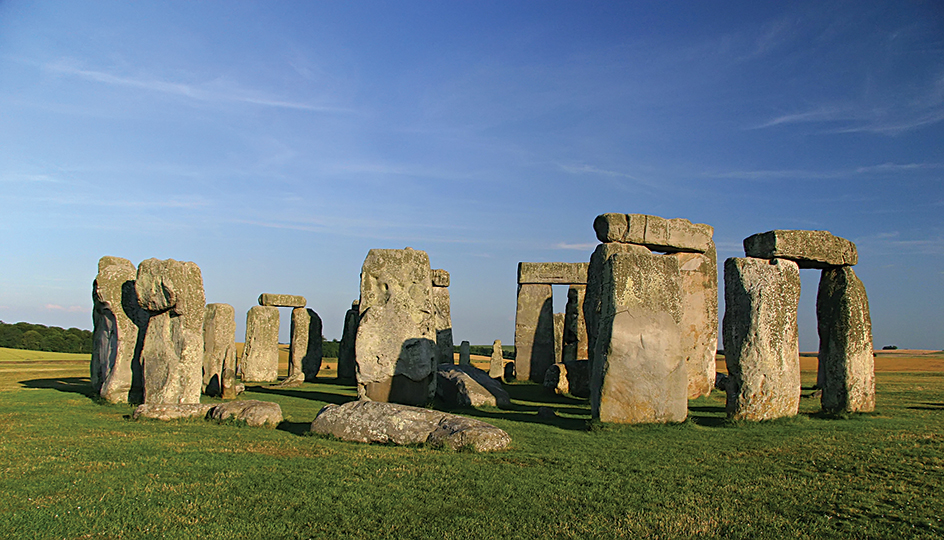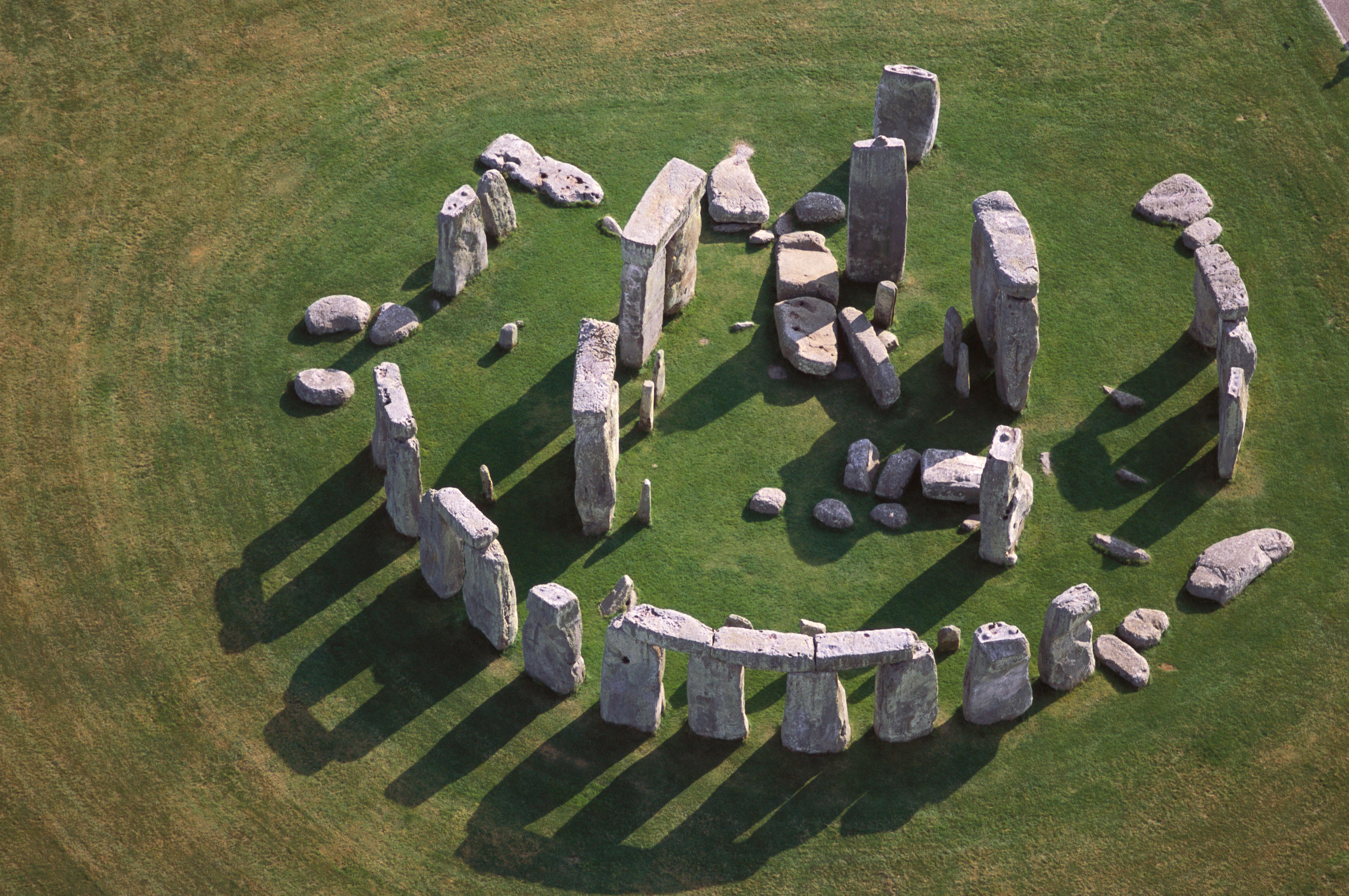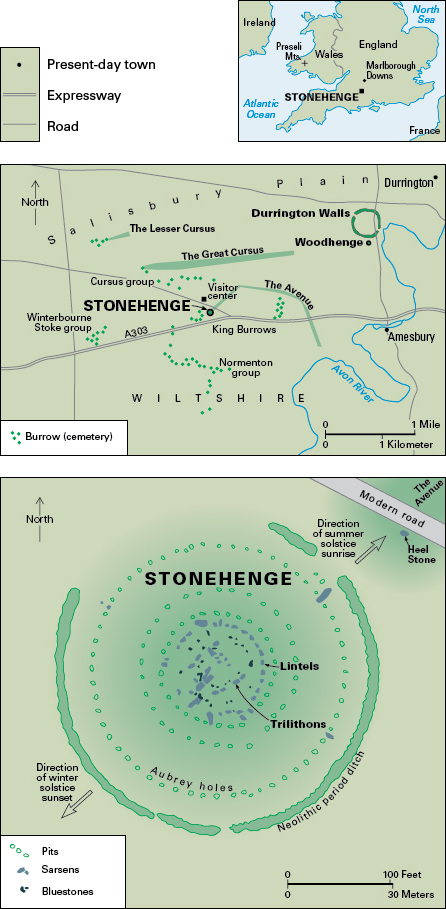Stonehenge, << STOHN hehnj, >> an ancient ruin in southwestern England, consists of huge, rough-cut stones set in a circle. Stonehenge lies on the Salisbury Plain in Wiltshire. Archaeologists think that the ancient inhabitants of the region constructed the site, using it as a gathering place and religious center. Stonehenge ranks as the most famous and elaborate of many similar ruins or henges found in the United Kingdom and Ireland.

Archaeologists have determined that Stonehenge was built in three phases over about 1,500 years. Beginning around 3100 B.C., Neolithic (late Stone Age) people dug a circular ditch about 360 feet (110 meters) in diameter at the site. They piled material removed from the ditch along its outside to construct a low earthen wall, producing a structure known as a ditch and bank enclosure. A series of 56 pits about 3 feet (1 meter) in diameter run along the inner edge of the enclosure. The pits, discovered by the British author John Aubrey, have become known as “Aubrey holes.” They may have originally held wooden posts. Over the next few centuries, ancient people used the Aubrey holes and the ditch for the burial of cremated remains.
Loading the player...Stonehenge
Around 2600 B.C., ancient people replaced the wooden circle with stone. They used dark volcanic rocks called bluestones quarried from the Preseli Mountains of Pembrokeshire in southern Wales. Scholars think workers dragged the bluestones—some of which weigh up to 4 tons (3.6 metric tons)—to the sea. There, they loaded the stones onto barges and sent them up Hampshire’s Avon River, unloading them near Stonehenge—a journey of about 245 miles (395 kilometers). Workers dragged the stones on sledges or rolled them into place on logs. However, the builders abandoned the site before completing the stone circle.

Workers rearranged the bluestones in the next phase of construction around 2300 B.C. At this time, they brought in huge gray sandstones called sarsens from quarries at Marlborough Downs, a site about 20 miles (32 kilometers) away. These stones weigh up to 25 tons (23 metric tons) and stand up to 131/2 feet (4.1 meters) tall. Builders used them to construct an outer circle surrounding the bluestones. They laid other sarsens atop the upright stones to form horizontal beams called lintels. This outer circle measured 108 feet (33 meters) in diameter. Its center contained five archlike stone settings, called trilithons, and a large altar stone. By 1500 B.C., this construction phase had ended.

Through the years, the huge stones gradually fell, and people took some stones to make bridges and dams. However, scholars have learned what the site looked like by studying the positions of the stones still in place.
Archaeological excavations in the area show that Stonehenge was part of a larger ceremonial center. A paved avenue once connected the site to the nearby Avon River. A similar avenue runs from the river to Durrington Walls, a Neolithic site about 2 miles (3 kilometers) from Stonehenge. Excavations at Durrington Walls reveal that it also had a ditch and bank enclosure. This enclosure surrounded a series of wooden posts arranged in six concentric circles—that is, circles sharing a common center. The outermost circle measured about 130 feet (40 meters) in diameter. Archaeologists call this formation the Southern Circle.

Scientists think that the Stonehenge and Durrington Walls were used together for religious ceremonies linked to the solstices, the times of the year that mark the beginning of summer and winter. The paved avenue at Stonehenge lines up with the sunrise on the summer solstice, and the avenue at Durrington Walls aligns with the sunset. The Southern Circle was aligned with the sunrise of the winter solstice, while Stonehenge was aligned with its sunset. Archaeologists think that people may have moved between the two sites by road and river to complete different parts of their rituals.
Archaeologists working at Durrington Walls have also uncovered the remains of the village that housed the builders of Stonehenge during its construction. They uncovered evidence that ancient people continued to use the settlement for feasting and religious rituals after the construction was complete. After 1500 B.C., later inhabitants of the area may have used Stonehenge for various purposes.
In 1922, the British government began to restore Stonehenge. Workers put some of the scattered stones back in their original positions. Today, Stonehenge is a popular tourist attraction. In 1986, the United Nations Educational, Scientific and Cultural Organization (UNESCO) designated Stonehenge and the surrounding landscape a World Heritage site, an area of unique natural or cultural importance.
See also Aubrey, John ; Megalithic monuments .
